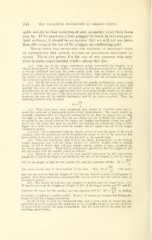Page 520 - My FlipBook
P. 520
244 THE TECHNICAL PKOCEDUBES IN FILLING TEETH.
quite strictly to that variation of size, no matter what their form
may be. If we must use a foot plugger to reach iu between prox-
imal surfaces, it should be so narrow that we will not use more
than this area of the toe of the plugger in condensing gold.
Rules thus f.vb developed for finding in simplest form
BY experiment THE ACTUAL POUNDS OR KILOGRAMS DELIVERED BY
BLOWS. These are given, for the use of any persons who may
wish to make experimental studies along this line.
(1.) With one of the larger instrument points, preferably the largest, in a
thrust dynamometer, finrl the number of pounds or kilograms required to cut through
a certain cardboard and bury the piece exactly flush with the surface of a certain
block of polished boxwood, using the end of the fiber. This relation of the paper to
the surface of the block should be carefully examined with the binocular microscope
and corrected until it is believed to be exact.
(2.) Divide the area of the point used by the pounds, or kilograms, stress found
in (I) to find the exact area of the wood (and cardboard) for one unit of force, and
multiply the area of each smaller (or larger) point by this number as the primary
determination of the stress required with each to produce results similar to the first;
or let A represent the area of the first instrument and S the stress found, and let Ai
represent the area of the smaller instrument and Si the stress required. Then the
following formula may be used:
A
(3.) When these have been calculated, they should be carefully tried succes-
sively for each size of instrument in the thrust dynamometer. The result should be
carefully examined with th; binocular microscope to see that the papers are not left
too high in the wood or that they are not thrust too far in below the surface. If
irregularities are found between the larger and smaller instruments (from one milli-
meter up) the whole line must be modified by starting the calculation from a little
higher or a little lower point until the results will be regular for all of the larger
instrument points.
Caution.— It is important with the smaller points to scau the grain of the wood
carefully with the microscope where irregularities occur, to see if the puncture has
been wholly iu the softer part or the harder part of the annual rings.
(4.) Place the instrument, first used in the thrust dynamometer, in the falling
weight apparatus and witli the larger mallet try different heights until a certain
height of fall is found tliat will give results exactly similar to those produced by
the thrust dynamometer. When this is satisfactory, proceed to find the height of fall
for this mallet with the smaller points as follows:
(5.) Multiply the area Ai of the next smaller instrument by the centimeters
height H of fall of the largest, and divide by the area of the largest A, and the result
HA'
will be the height of fall for the smaller Hi, and the equation will be: H' =
A
JTgl
The stress found may be used instead of the area. Thus H' = —^ This latter
may also be used to find the height of fall for any desired number of kilograms or
pounds, when these have been experimentally proven correct for the various sizes of
instrument jioints.
(6.) The height of fall for any weights of mallets may be found thus: Let
W and H represent the weight and height of fall of the larger mallet and Wi and Hi
WII
represent the same for the smaller, and the equation will be: H' = -rrFf in finding
the height of fall for a smaller mallet. It may, of course, be reversed for finding the
height of fall for a larger instrument.
In all of this, it must be understood that such a scale must be found for the
particular piece of wood and the particular piece of cardboard used; no two of either
of these will be exactly the same in hardness. But the rules will be the same for all,
including metal blocks.


